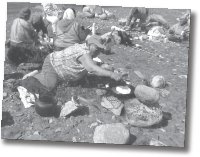Writing Short Pieces from an Interview
- Choose a focus for your piece of writing. Look at the themes and categories
that you identified in the interview. You won’t write about everything that the
storyteller spoke about. Which theme or category interests you?
- Decide who you are writing for. Who is your audience? Nunavummiut in
general, community residents, group members, children? How you write will
depend on who your audience is.
- Choose the parts of the interview that it into your theme or category. You
have to try to keep your story moving along fast enough to keep your readers
engaged. So you may not be able to put in everything that interests you.
- Decide if you are going to be in your story or not. There are a few different
ways to approach this:
- Keep the interview format, with your questions and the storyteller’s
responses. Magazine articles are sometimes done in this way.
- Remove yourself from the story altogether. Use only the storyteller’s words,
making the story low along from one part to the next. You might need to
invent a few sentences that reflect your questions. You might use your own
words in the beginning where you introduce the storyteller and the process
you went through together.
- Let the storyteller speak in the first person (I or we) and you write
connecting passages in the third person (he, she or they). Weave the two
styles together to create a balanced story.
- You will likely have to write your own transitions to make one part of the story
low along to the next part. These might be a few sentences that help your
reader understand the story better.
- Then you will have to write a beginning and an end to your story.
The beginning could be:
- the storyteller’s own words for a paragraph or two;
- a short biography of the storyteller’s life;
- a description of the setting where you interviewed the storyteller; or
- or you could start with the reason you wanted to interview the storyteller.
The ending could be:
- the storyteller’s own words to wrap up the story;
- a summary written by you, explaining why the story is important; or
- your feelings and opinions about the interview process as you
experienced it.
- Choose photographs to go in the story and captions for them.
- Write a title and subtitles if you want to use them.
- Edit your piece of writing. Give it to other people and get their comments.
Then edit it with a partner looking for sequence – is everything in the best
order? Look at how you organized your paragraphs. In the final edit look at
sentence structure, grammar and spelling.


